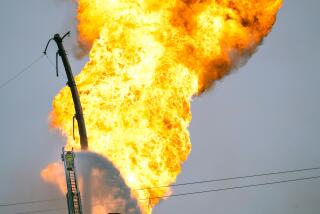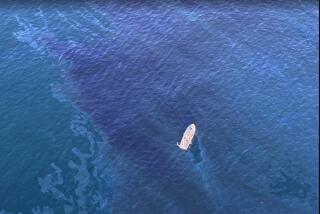BP looks for new plan to stop leak
After failing in their attempt to funnel the oil leaking under the Gulf of Mexico with a 100-ton box, BP officials on Sunday were considering deploying a smaller container that might be less prone to clogging.
Capping the leak with a smaller box would ensure the oil and seawater mixture inside was warm enough to prevent the formation of slush that last week clogged the larger container, UC Santa Barbara geochemist David Valentine said. Gas mixing with cold water near the sea floor can form a matrix that is similar to crystal.
The plan was for the oil-and-water mixture to flow from the containment box through a pipe to the oceanâs surface, where it would be collected inside waiting tankers. BP officials had warned that the procedure had never been attempted so deep in the ocean.
The smaller box, which could be deployed in a few days, is one of several options BP is considering, company spokesman Tom Mueller said. Another is a âhot tap,â in which a hole would be drilled into the existing broken pipe through which the oil could be drawn out. Robotic submarines would install a connector between the old pipe and the new.
BP also is considering a âjunk shotâ option, Mueller said. That would involve injecting solid rubbery and fibrous material into the broken mechanism at the well head to stop it up. The temporary clog would give engineers time to use heavy fluids and cement to create a more permanent barrier.
The drilling of a relief well, which could take three months, was continuing.
Meanwhile, Louisiana state authorities on Sunday extended a no-fishing zone farther west, to Atchafalaya Bay, as the forked oil plume menaced the stateâs south and east shores. A state of emergency was declared in Lafourche Parish, west of the Mississippi River, and the slick edged into Chandeleur and Breton sounds, east of New Orleans.
Authorities said they had laid about 190 miles of boom and were employing 277 vessels, 10,000 personnel and an armada of volunteers, many of them fishermen fighting to save their livelihoods.
Weather and wind predictions show that the westward-moving oil slick will probably hit numerous ecologically sensitive shores near the mouth of the Mississippi River and around the marshes of southeastern Louisiana.
Sunday was the second day in a row that crews were unable to set controlled burns on the water, because of choppy seas and unfavorable wind conditions, said U.S. Coast Guard Petty Officer Brandon Blackwell. In the three previous days, these burns removed an estimated 10,000 to 13,000 barrels of oil, according to Al Allen, who is working on the project.
At least 5,000 barrels of oil have continued to flow into the gulf each day since the Deepwater Horizon rig was engulfed in flames on April 20 and sank, leaving 11 men missing and presumed dead.
The oilâs impact already is being felt from the southeastern tip of Louisiana to the mouth of Mobile Bay in Alabama.
Krista Schlyer, a freelance photographer working for the group Defenders of Wildlife, said she saw an oily sheen churning in the surf around Breton Island, part of a chain of barrier islands north of the mouth of the Mississippi. The island is part of the Breton National Wildlife Refuge, home to endangered and threatened birds including the brown pelican, least tern and piping plover.
On Dauphin Island just outside Mobile Bay, reporters for the Mobile Press-Register this weekend found charcoal-like âtar pattiesâ that smelled like lighter fluid spread over miles of beach.
The U.S. Fish and Wildlife Service announced it had cleaned two birds, a northern gannet and a brown pelican, and would release them Monday afternoon at Pelican Island National Wildlife Refuge northeast of Vero Beach, Fla.
âI canât even turn on the news, it makes me sick,â said Emile Serigne, a fisherman sitting in the shade of Sharonâs Shack, a bait and tackle store in St. Bernard Parish, La. Serigne canât farm oysters until the water is cleaned up, and every day, he said, it seems like the cleanup situation gets worse and worse.
Details continued to emerge about the explosion that initiated the disaster. Attorney Scott Bickford of New Orleans confirmed Sunday that his client, a worker on the rig, was the man whose anonymous account of the blast circulated widely on the Internet.
The anonymous worker described a âhumongous gas bubbleâ that pushed from below the Earthâs surface to the rigâs crown about 240 feet in the air, eventually igniting its deck in a giant tower of flame.
The worker, who Bickford said wished to remain anonymous to avoid publicity, told his story on an April 30 episode of the Mark Levin talk radio show.
The worker offered the following account:
On April 20, the Horizonâs crew was nearly finished preparing the well for future pumping. But in order to cement the top of the well, plugging it until the next crew came to tap it, they first had to open a valve in a blowout preventer, which can be closed in the event of a surge of natural gas to protect the rig.
âWhen they opened the well is when the gas well kicked, and we took a humongous gas bubble up through the well bore,â the worker said. âIt literally pushed the seawater all the way to the crown of the rig, which is about 240 feet in the air.â
This particular well, he said, âhad a bad history of producing lots of gas.â In this case, he added, âthe sheer volume and pressure of gas that hit all at once ⦠was more than the safeties and controls we had in place could handle.â
Levin, the radio host, asked him if he believed someone was at fault.
The blowout âcould very well be a once-in-a-lifetime freak accident, or it could be negligence,â the worker said. âThatâs for other people to figure out. From my position, it just seems like every now and then, you canât win against Mother Nature. She throws a curve ball that you are not prepared for.â
Fausset reported from Atlanta; Cart reported from Bayou La Batre, Ala.; and Semuels reported from St. Bernard Parish, La.
More to Read
Sign up for Essential California
The most important California stories and recommendations in your inbox every morning.
You may occasionally receive promotional content from the Los Angeles Times.











